First Rain
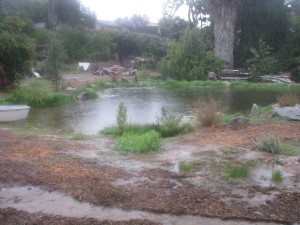
The first week of October and we’re having a day of heavy rain… almost unbelievable. Normally October in San Diego is high fire season. The brush is crisp from months of drought and high temperatures, and then the Santa Ana winds begin: wild dry winds that blow east to west from the deserts, full of static and mad gusts that turn brush fires into firestorms.
My property is a watershed, funneling rainwater from the street through to the streambed in the barranca below, taking all my topsoil and some of the embankment with it. This year I had the beginnings of a permaculture garden installed to remedy this pattern. By deepening the loam and placing berms around plant guilds water is encouraged to pool up and soak in rather than run off. Overflow is channeled through a series of dry ponds which allow water to soak into the ground. From there it is channeled safely down to an overflow into the stream. Today was an early test of what has been worked on since Feb. 1.
The tilling, mulching and berming done by the crew of landscape architect Roger Boddaert proved successful.
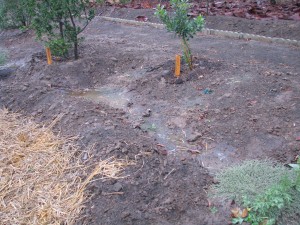
The soil has a high clay content, which was good news when digging the large pond because it held water without a liner. It is bad news for other areas of the garden where water is pooling up instead of sinking in. I was able to take note of these areas this afternoon so that they could be drained and mulched for more absorption.
Aquascape, the company that installed the series of ponds, is still planting and maintaining the waterways. Jacob came out in the rain and watched it flow, shaping and fortifying as the force of the rain and thus the volume increased.
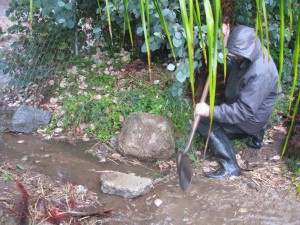
Water flowed under the fence from the street, but instead of flooding a cement culvert as it used to do, it is channeled down to the ponds.
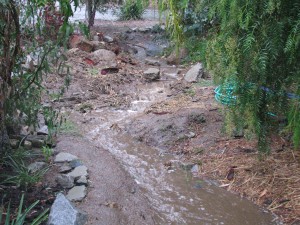

Silt and debris blocked water flow under the bridge, and was eroding the area by the structure called the Nest. I cleared the debris and raked rocks and silt to the weak side, and that fixed the problem temporarily.
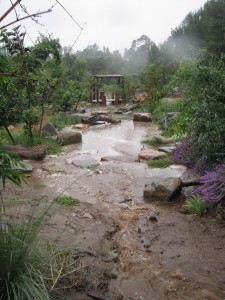
Water quickly filled the first dry pond; with the high clay content, water percolates but does it slowly.
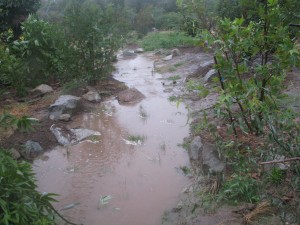
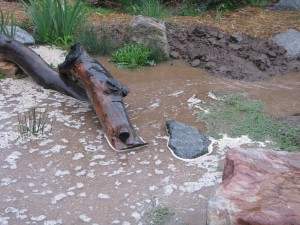
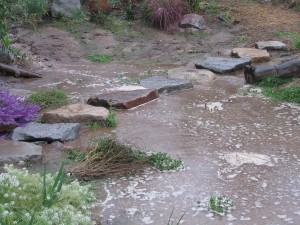
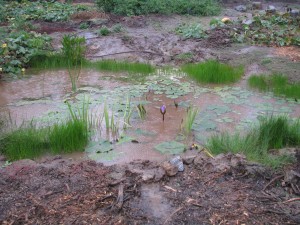
As water reached the small pond, which wasn’t intended to permanently hold water but the clay had a different idea, the sides had to be shored up and the overflow diverted.
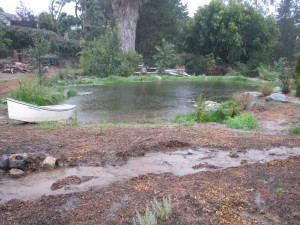
Extra floodwaters aren’t being diverted into the large pond because we don’t want it filled with silt, and we don’t want it overflowing rapidly and eroding the sides. Instead the water flows through a channel around the large pond, then down to a prescribed place to flow out and over the embankment to the stream below.
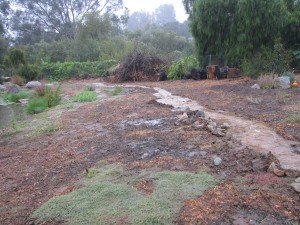
Some areas of heavy erosion had been filled and supported, and as of six this evening they looked wet but not iffy. What a night of heavy rain will do, I’ll have to see in the morning. I am very lucky to have this type of
rain early in the season. It has been heavy enough to cause significant water flow to help shape the watercourse and show weak spots, and the rain will be reduced to showers tomorrow then clear up, so repairs and improvements can be made before true flooding happens later in the year or early in the next.
Although much more water is being held on the property, and topsoil is not being lost, it still pains me to see so much rain channeled out to the stream. Rainwater is a neutral Ph, and carries nitrogen (especially when
there is lightning). It is the best possible water for plants, as well as for human consumption and bathing. In side-by-side comparisons with tap water, plants watered with rainwater flourish far beyond the growth of the others. I’m greedy to hold that water onto my property, letting it soak as deeply as possible for tree roots to use far into the year. As the newly planted trees grow, their roots will help hold water and soil. As their leaves drop the mulch levels will raise, aided by compost and mulch that I will be constantly adding, and the soil will become more absorbent farther down. Each rain should have less runoff and more absorption. This rain has shown a great success with the garden, but I know it is only the beginning.